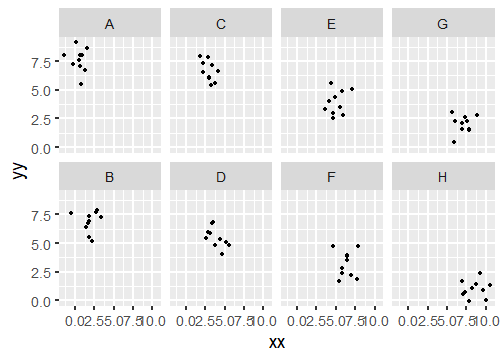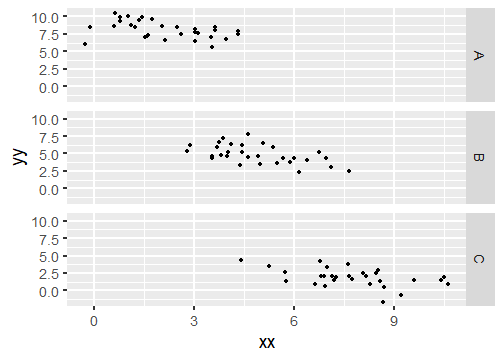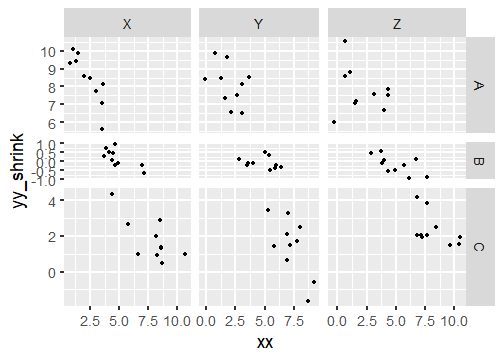class: center, middle, inverse, title-slide # Introduction to ggplot2 ## Advanced plotting in R 2021 ### Michael Matiu ### 2021/05/11 --- ## Content .pull-left[ ### Block 1 (Intro and EDA) - Fundamentals of ggplot2 + Data + Language - Building blocks + Mapping + Layering + Facetting - ggplot2 for EDA (exploratory data analysis) - some other gg packages **HANDS ON DATA** ] .pull-right[ ### Block 2 (publication-ready plots) - Basics of design - Styling of ggplots - Arranging multiple ggplots - Annotating - Polishing **HANDS ON DATA** ] --- ## What is ggplot2? Declarative plotting system built around the [Grammar of Graphics](https://www.amazon.com/Grammar-Graphics-Statistics-Computing/dp/0387245448/ref=sr_1_1?dchild=1&keywords=the+grammar+of+graphics&qid=1620283819&sr=8-1). Created by Hadley Wickham some 10 years ago. Declarative means: You need to define links to data, and ggplot will take care of the rest (axes, limits, scales, colours, labels, legends, ...). --- ## Why ggplot2? Good: + easy to explore different visualizations + sensible default scales (x, y, colour, ...) + automatic legends + allows fast data exploration of multi-dimensional data by using different aesthetics (position, colour, shape, size, ...) and facetting + all-in-one-solution: good for both EDA (exploratory data analysis) and publication-ready figures Bad: - fine-tuning can be tedious - sometimes, if you want to override ggplot2 defaults, it can be hacky or impossible --- ## Tidy data ggplot2 is built around **tidy** data sets (data.frame, tibble, data.table). <img src="https://d33wubrfki0l68.cloudfront.net/6f1ddb544fc5c69a2478e444ab8112fb0eea23f8/91adc/images/tidy-1.png"> .tiny[R4DS, https://r4ds.had.co.nz/tidy-data.html#tidy-data-1] --- ## Data wrangling: Observations in columns ```r table4 %>% pivot_longer(c(`1999`, `2000`), names_to = "year", values_to = "cases") ``` <img src="https://d33wubrfki0l68.cloudfront.net/3aea19108d39606bbe49981acda07696c0c7fcd8/2de65/images/tidy-9.png"> .tiny[R4DS, https://r4ds.had.co.nz/tidy-data.html#longer] --- ## Data wrangling: Observations scattered across rows ```r table2 %>% pivot_wider(names_from = key, values_from = value) ``` <img width=70% height=70% src="https://d33wubrfki0l68.cloudfront.net/8350f0dda414629b9d6c354f87acf5c5f722be43/bcb84/images/tidy-8.png"> .tiny[R4DS, https://r4ds.had.co.nz/tidy-data.html#wider] --- ## Data wrangling: Transformation ```r # select observations flights %>% filter(month == 1, day == 1) # create new columns flights %>% mutate(gain = dep_delay - arr_delay, speed = distance / air_time * 60) # summarize by groups flights %>% group_by(year, month, day) %>% summarise(delay = mean(dep_delay, na.rm = TRUE)) ``` --- ## ggplot2 components and language #### Minimally required - A default dataset - Set of mappings from variables to aesthetics - One or more layers, each composed of + a geometric object #### Optional (to override defaults) - For each layer + a statistical transformation + a position adjustment + optionally, different dataset and aesthetic mappings - One scale for each aesthetic mapping - A coordinate system - The faceting specification --- ## Aesthetics Describe graphical elements Continuous vs. discrete <img width=80% height=80% src="https://clauswilke.com/dataviz/aesthetic_mapping_files/figure-html/common-aesthetics-1.png"> .tiny[Source: Claus O. Wilke, *Fundamentals of Data Visualization*, https://clauswilke.com/dataviz/aesthetic-mapping.html] --- ## Scales Map data values onto aesthetics <img src="https://clauswilke.com/dataviz/aesthetic_mapping_files/figure-html/basic-scales-example-1.png"> .tiny[Source: Claus O. Wilke, *Fundamentals of Data Visualization*, https://clauswilke.com/dataviz/aesthetic-mapping.html#scales-map-data-values-onto-aesthetics] --- ## Geoms - Basic building blocks <img width=20% height=20% src="https://ggplot2-book.org/individual-geoms_files/figure-html/geom-basic-1.png"> <img width=20% height=20% src="https://ggplot2-book.org/individual-geoms_files/figure-html/geom-basic-2.png"> <img width=20% height=20% src="https://ggplot2-book.org/individual-geoms_files/figure-html/geom-basic-3.png"> <img width=20% height=20% src="https://ggplot2-book.org/individual-geoms_files/figure-html/geom-basic-4.png"> <img width=20% height=20% src="https://ggplot2-book.org/individual-geoms_files/figure-html/unnamed-chunk-2-1.png"> <img width=20% height=20% src="https://ggplot2-book.org/individual-geoms_files/figure-html/unnamed-chunk-2-2.png"> <img width=20% height=20% src="https://ggplot2-book.org/individual-geoms_files/figure-html/unnamed-chunk-2-3.png"> <img width=20% height=20% src="https://ggplot2-book.org/individual-geoms_files/figure-html/unnamed-chunk-2-4.png"> .tiny[Source: Hadley Wickham, *ggplot2 book*, https://ggplot2-book.org/individual-geoms.html] --- ## Code structure ```r ggplot(data = <DATA>)+ # REQUIRED <GEOM_FUNCTION>(mapping = aes(<MAPPINGS>), # REQUIRED stat = <STAT>, position = <POSITION>)+ # optional <COORDINATE_FUNCTION>+ # optional <FACET_FUNCTION>+ # optional <SCALE_FUNCTION>+ # optional <THEME_FUNCTION> # optional ``` --- ## Layering .panelset[ .panel[.panel-name[Base] .pull-left[ ```r *ggplot(mpg, aes(displ, hwy)) ``` ] .pull-right[ <!-- --> ] ] .panel[.panel-name[1 geom] .pull-left[ ```r ggplot(mpg, aes(displ, hwy))+ * geom_point() ``` ] .pull-right[ <!-- --> ] ] .panel[.panel-name[2 geoms] .pull-left[ ```r ggplot(mpg, aes(displ, hwy))+ geom_point()+ * geom_smooth() ``` ] .pull-right[ <!-- --> ] ] .panel[.panel-name[3 geoms] .pull-left[ ```r ggplot(mpg, aes(displ, hwy))+ geom_point()+ geom_smooth()+ * geom_hline(yintercept = 30, linetype = "dashed") ``` ] .pull-right[ <!-- --> ] ] ] --- ## Inheritance of aes() All of these produce the same plot: ```r ggplot(mpg, aes(displ, hwy, colour = class)) + geom_point() ggplot(mpg, aes(displ, hwy)) + geom_point(aes(colour = class)) ggplot(mpg, aes(displ)) + geom_point(aes(y = hwy, colour = class)) ggplot(mpg) + geom_point(aes(displ, hwy, colour = class)) ``` Within each layer you can add, override, or remove (set to `NULL`). --- ## Setting vs. mapping of aesthetics .panelset[ .panel[.panel-name[Mapping] .pull-left[ Within `aes()` the aesthetic is mapped to a variable. ```r ggplot(mpg, aes(displ, hwy))+ * geom_point(aes(colour = drv)) ``` ] .pull-right[ <!-- --> ] ] .panel[.panel-name[Setting] .pull-left[ Outside `aes()` the aesthetic is set to a value. Needs to be a possible value then. ```r ggplot(mpg, aes(displ, hwy))+ * geom_point(colour = "darkblue") ``` ] .pull-right[ <!-- --> ] ] .panel[.panel-name[Setting in aes()] .pull-left[ What happens, if we set a value within `aes()`? ```r ggplot(mpg, aes(displ, hwy))+ * geom_point(aes(colour = "darkblue")) ``` ] .pull-right[ <!-- --> ] ] .panel[.panel-name[Mapping constants] .pull-left[ One can also "manually" construct mappings. Can be useful in certain cases. ```r ggplot(mpg, aes(displ, hwy)) + geom_point() + * geom_smooth(aes(colour = "loess"), method = "loess", se = FALSE) + * geom_smooth(aes(colour = "lm"), method = "lm", se = FALSE) ``` ] .pull-right[ <!-- --> ] ] ] --- ## Coordinate systems Not that relevant, since mostly the Cartesian one is used. However you can force a fixed aspect ratios `coord_fixed()` or use polar coordinates `coord_polar()`. This flexibility allows easy extension: `coord_sf()` for spatial data (`->` Mattia). --- ## Facetting - Basics Generate small multiples based on subsets of the data. Incredibly powerful technique. ggplot offers two different options: <img src="https://ggplot2-book.org/diagrams/position-facets.png"> .tiny[Source: ggplot2 book, https://ggplot2-book.org/facet.html] --- ## facet_wrap .panelset[ .panel[.panel-name[base] .pull-left[ ```r # some random data n_grp <- 8 n_points <- 10 tbl_wrap <- tibble( grp = rep(LETTERS[1:n_grp], each = n_points), xx = rep(1:n_grp, each = n_points) + rnorm(n_grp*n_points), yy = rep(n_grp:1, each = n_points) + rnorm(n_grp*n_points) ) ``` ```r # wrap grp ggplot(tbl_wrap, aes(xx, yy))+ geom_point()+ * facet_wrap(~grp) ``` ] .pull-right[ <!-- --> ] ] .panel[.panel-name[free scales] .pull-left[ ```r ggplot(tbl_wrap, aes(xx, yy))+ geom_point()+ * facet_wrap(~grp, scales = "free") ``` Also possible to use `"free_x"` or `"free_y"`. ] .pull-right[ <!-- --> ] ] .panel[.panel-name[nrow ncol] .pull-left[ ```r ggplot(tbl_wrap, aes(xx, yy))+ geom_point()+ * facet_wrap(~grp, nrow = 2) ``` Also possible to specify number of columns with `ncol = `. ] .pull-right[ <!-- --> ] ] .panel[.panel-name[Order of wrapping] .pull-left[ ```r ggplot(tbl_wrap, aes(xx, yy))+ geom_point()+ * facet_wrap(~grp, nrow = 2, dir = "v") ``` Standard is `dir = "h"`. ] .pull-right[ <!-- --> ] ] .panel[.panel-name[Order of elements] .pull-left[ The order of facets is determined by the underlying factor. If it's a character vector, then alphabetically. In order to change the order, you need to modify the factor. ```r tbl_wrap %>% mutate(grp_f = fct_relevel(factor(grp), "B", "G", "E", "F", "D", "A", "C", "H")) %>% ggplot(aes(xx, yy))+ geom_point()+ facet_wrap(~grp_f, nrow = 2) ``` ] .pull-right[ <!-- --> ] ] ] --- ## facet_grid .panelset[ .panel[.panel-name[x ~ .] .pull-left[ ```r # some random data n_points <- 10 tbl_grid <- tibble( grp1 = rep(c("A", "B", "C"), each = n_points*3), grp2 = rep(rep(c("X", "Y", "Z"), n_points), 3), xx = rep(1:9, each = n_points) + rnorm(9*n_points), yy = rep(9:1, each = n_points) + rnorm(9*n_points) ) ``` ```r # plot ggplot(tbl_grid, aes(xx, yy))+ geom_point()+ * facet_grid(grp1 ~ .) ``` ] .pull-right[ <!-- --> ] ] .panel[.panel-name[. ~ y] .pull-left[ ```r ggplot(tbl_grid, aes(xx, yy))+ geom_point()+ * facet_grid(. ~ grp2) ``` ] .pull-right[ <!-- --> ] ] .panel[.panel-name[x ~ y] .pull-left[ ```r ggplot(tbl_grid, aes(xx, yy))+ geom_point()+ * facet_grid(grp1 ~ grp2) ``` ] .pull-right[ <!-- --> ] ] .panel[.panel-name[free space] .pull-left[ Besides free scales, for `facet_grid` you also have `space =`. So height/width is proportional to range of data. ```r tbl_grid %>% mutate(yy_shrink = if_else(grp1 == "B", (yy - mean(yy))/sd(yy), yy)) %>% ggplot(aes(xx, yy_shrink))+ geom_point()+ facet_grid(grp1 ~ grp2, scales = "free", * space = "free") ``` ] .pull-right[ <!-- --> ] ] .panel[.panel-name[free space 2] .pull-left[ This is especially useful for categorical scales. See example on the right from https://ggplot2-book.org/facet.html#controlling-scales ] .pull-right[ <img width=70% height=70% src="https://ggplot2-book.org/facet_files/figure-html/discrete-free-1.png"> ] ] ] --- ## facets with continuous variables If you want to facet on continuous variables, you need first to discretise it. ggplot offers three helper functions: - `cut_width(x, w)` <br> makes bins of the same width `w` - `cut_interval(x, n)` <br> makes `n` bins of equal width - `cut_number(x, n)` <br> makes `n` bins that approximately contain the same number of observations (with varying width) Or you can use the base `cut()` function, which also allows you manually specify the breaks and labels. --- ## Grouping vs. facetting .panelset[ .panel[.panel-name[Question] Should you use groups (e.g. colour) or facets? The answer is both. And ggplot makes it easy to switch and try out all the options. ] .panel[.panel-name[groups] .pull-left[ ```r ggplot(tbl_grid, aes(xx, yy, colour = grp2))+ geom_point() ``` ] .pull-right[ <!-- --> ] ] .panel[.panel-name[facets] .pull-left[ ```r ggplot(tbl_grid, aes(xx, yy))+ geom_point()+ facet_grid(. ~ grp2) ``` ] .pull-right[ <!-- --> ] ] .panel[.panel-name[both] .pull-left[ ```r ggplot(tbl_grid, aes(xx, yy, colour = grp1))+ geom_point()+ facet_grid(. ~ grp2) ``` ] .pull-right[ <!-- --> ] ] ] --- ## saving plots .panelset[ .panel[.panel-name[as R objects] You can save the call to `ggplot()+...` as R object. ```r *gg <- ggplot(tbl_wrap, aes(xx, yy))+ geom_point()+ facet_wrap(~grp) ``` Some people use this to construct a plot sequentially. ```r gg <- ggplot(tbl_wrap, aes(xx, yy)) gg <- gg + geom_point() gg <- gg + facet_wrap(~grp) ``` ] .panel[.panel-name[as files] ```r ggsave( filename = "abc.pdf", plot = gg, width = 6, height = 4 ) ``` - if you omit the `plot = ` argument, then the last plot is saved - based on the ending of the filename, ggplot will choose the right device and sage the appropriate file, including PDF, PNG, JPG, TIFF, ... - width and height are by default given in inches, but can choose cm or mm with the `units=` argument, e.g. `units = "cm"` - tip to determine the plot size: plot it in the RStudio plots pane, use the "Export" button with "Save as PDF", use the "Preview" button, and play around with sizes ] ] --- ## ggplot for EDA .panelset[ .panel[.panel-name[Why?] The ggplot grammar makes it easy to try out and switch between many plots. - explore many geoms - exchange aesthetics - use facets - exchange facets with aesthetics ] .panel[.panel-name[facet more variables] .pull-left[ Using `+` you can add multiple groups to facet over ```r ggplot(tbl_grid, aes(xx, yy))+ geom_point()+ * facet_wrap(~ grp1 + grp2) ``` ] .pull-right[ <!-- --> ] ] .panel[.panel-name[loop and save] ```r # get limits xl <- range(tbl_wrap$xx) yl <- range(tbl_wrap$yy) # open pdf file (graphics device) pdf("gg-loop.pdf", width = 6, height = 4) # loop through all for(i_grp in sort(unique(tbl_wrap$grp))){ gg <- tbl_wrap %>% filter(grp == i_grp) %>% # filter to grp ggplot(aes(xx, yy))+ geom_point()+ xlim(xl)+ # enforce same limits ylim(yl)+ ggtitle(paste0("Group: ", i_grp)) # add some info print(gg) # inside for() loop needs a print() of the gg object } # close the pdf (device) dev.off() ``` ] ] --- ## some additional packages `->` external file --- ## Now it's your turn! .pull-left[ ### A) Structured exercises Go to the folder `02_Ggplot/exercises/` and start hacking! Solutions will be provided after the end of the day. ] .pull-right[ ### B) Freely explore data If you brought own data: Use it! Otherwise, feel free to use the provided data in `00_Data/`. Consult the `Readme.md` inside for more info. Explore, find patterns, try to answer question you have on the data, ... ]